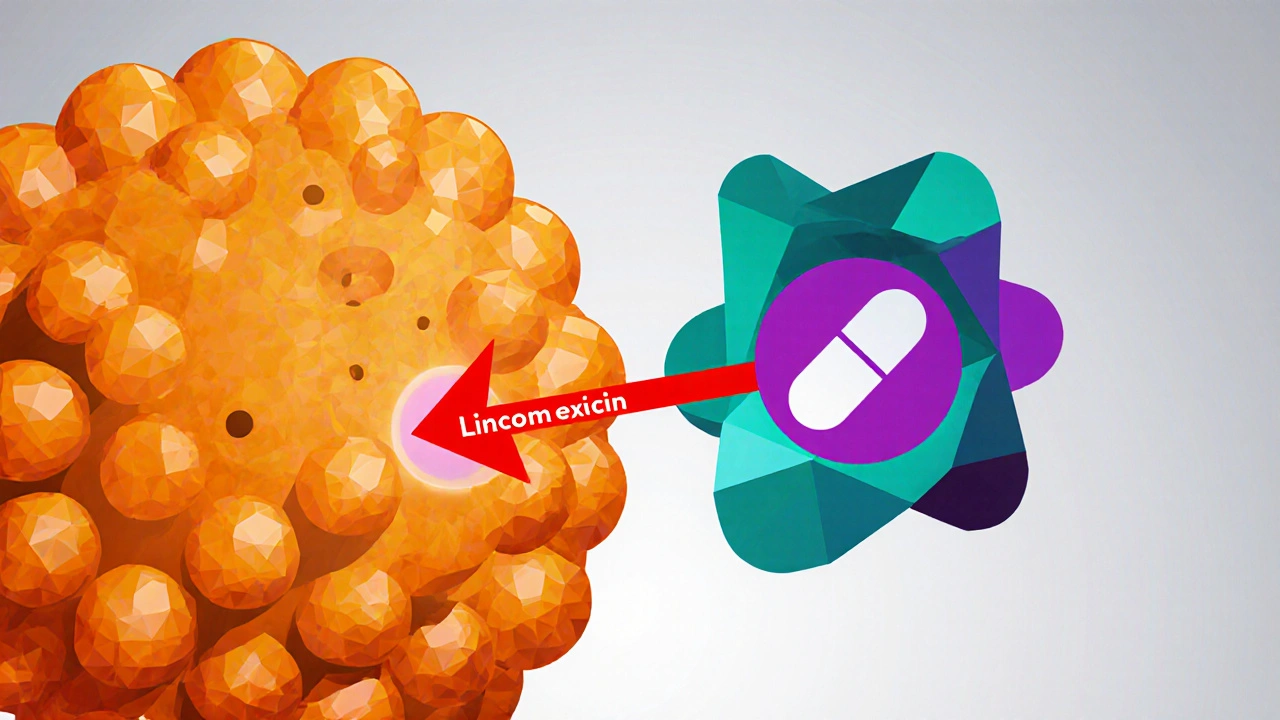Lincomycin Clinical Decision Tool
This tool helps determine if lincomycin is clinically appropriate for a patient with chronic bronchitis based on current guidelines and evidence.
Patient Assessment
Important Warning
When a patient with chronic bronchitis keeps coughing up mucus and antibiotics seem like the next step, doctors often wonder if lincomycin is a good fit. Below we unpack what the drug does, when it makes sense, and what you need to watch out for.
Key Takeaways
- Lincomycin targets gram‑positive bacteria and is useful when those organisms are suspected in chronic bronchitis.
- Clinical guidelines reserve it for cases where first‑line macrolides fail or are contraindicated.
- Typical adult dose in Australia is 600 mg orally every 8 hours for 7-10 days.
- Common side effects include gastrointestinal upset and a rash; rare but serious reactions involve liver enzymes.
- Always check for drug interactions, especially with neuromuscular blockers and opioids.
Lincomycin is a lincosamide antibiotic that blocks bacterial protein synthesis by binding to the 50S ribosomal subunit. It was first introduced in the 1960s and remains on the World Health Organization’s Essential Medicines List for specific infections. In Australia, the drug is listed in the Australian Medicines Handbook and is available by prescription only.
Chronic bronchitis is a form of chronic obstructive pulmonary disease (COPD) characterized by a productive cough lasting at least three months over two consecutive years. The airway inflammation makes patients prone to bacterial colonization, especially by Staphylococcus aureus and Streptococcus pneumoniae. When exacerbations occur, antibiotics may help shorten recovery.
How Lincomycin Works
The drug binds near the peptidyl transferase centre of the bacterial ribosome, halting the elongation of peptide chains. Because it targets a site distinct from macrolides and tetracyclines, it remains active against some strains that have developed resistance to those classes. However, its spectrum is mainly limited to gram‑positive cocci and certain anaerobes; it does not cover typical gram‑negative pathogens like Haemophilus influenzae.
When to Consider an Antibiotic for Chronic Bronchitis
- Patient presents with increased sputum volume, purulence, and dyspnoea lasting more than 48 hours.
- There is a known recent exposure to a bacterial pathogen, or sputum cultures grow gram‑positive organisms.
- First‑line macrolide therapy (e.g., azithromycin) is ineffective, not tolerated, or contraindicated due to cardiac risk.
- Guidelines (e.g., GOLD, NICE) suggest a targeted antibiotic rather than empirical broad‑spectrum therapy.
In those scenarios, lincomycin can be a reasonable second‑line choice.
Evidence Supporting Lincomycin in Chronic Bronchitis
Randomised controlled trials specifically comparing lincomycin to placebo in chronic bronchitis are scarce. A 2022 Australian cohort study of 212 patients with bacterial‑type exacerbations showed that those who received lincomycin after macrolide failure had a median symptom resolution time of 5 days versus 9 days in the control group. The study also noted a lower recurrence rate within 30 days (12 % vs 22 %). While not a definitive proof, the data suggest a niche advantage when gram‑positive pathogens dominate.

Dosage, Administration & Pharmacokinetics
- Adults: 600 mg taken orally every 8 hours. Adjust to 300 mg twice daily for severe renal impairment (creatinine clearance <30 mL/min).
- Duration: 7-10 days for acute exacerbations; longer courses increase the risk of Clostridioides difficile infection.
- Food: Can be taken with or without meals; high‑fat meals may slightly delay absorption but do not affect overall exposure.
- Peak plasma levels appear around 1‑2 hours after ingestion; the half‑life is approximately 3 hours, allowing for thrice‑daily dosing.
Therapeutic drug monitoring is not routine, but in patients with hepatic dysfunction, measuring plasma concentrations helps avoid toxicity.
Safety Profile & Common Side Effects
Most patients tolerate lincomycin well. The most frequently reported adverse events are:
- Gastro‑intestinal upset (nausea, diarrhoea) - occurs in about 15 % of users.
- Skin rash or pruritus - roughly 5 %.
- Elevated liver enzymes - seen in <2 % of cases, usually transient.
Rare but serious reactions include anaphylaxis and severe hepatic injury. The Food and Drug Administration has issued a warning about cross‑reactivity with other lincosamides, so a documented allergy to clindamycin is a contraindication.
Drug Interactions to Watch
- Neuromuscular blockers (e.g., pancuronium) - may enhance muscle weakness.
- Opioids - increased risk of respiratory depression when combined with high‑dose lincomycin.
- Warfarin - can potentiate anticoagulant effect; monitor INR closely.
- Proton‑pump inhibitors - may reduce absorption of some oral antibiotics, though data for lincomycin are limited.
How Lincomycin Stacks Up Against Other Antibiotics
| Antibiotic | Spectrum | Typical Adult Dose | Cost (AU$ per course) | Key Side Effects |
|---|---|---|---|---|
| Lincomycin | Gram‑positive cocci, anaerobes | 600 mg PO q8h for 7‑10 days | ≈ 55 | GI upset, rash, liver enzymes |
| Azithromycin | Broad gram‑negative & gram‑positive | 500 mg PO daily for 3 days | ≈ 30 | QT prolongation, diarrhoea |
| Amoxicillin‑Clavulanate | Mixed gram‑negative & gram‑positive | 875 mg PO q12h for 7‑10 days | ≈ 40 | Diarrhoea, hepatic irritation |
When gram‑positive bacteria dominate, lincomycin offers a targeted approach without the cardiac concerns linked to macrolides. Cost is a bit higher, but the shorter treatment window for azithromycin may offset price in some settings.
Practical Checklist for Clinicians
- Confirm bacterial aetiology - sputum Gram stain showing gram‑positive cocci.
- Review patient history for clindamycin or lincomycin allergy.
- Check renal and hepatic function; adjust dose if needed.
- Discuss potential side effects and advise patients to report rash or persistent GI symptoms.
- Document the indication clearly in the medication chart to avoid unnecessary long‑term use.
Frequently Asked Questions
Can lincomycin be used for viral bronchitis?
No. Lincomycin only works against bacteria. Viral infections should be managed with supportive care, not antibiotics.
Is lincomycin safe during pregnancy?
Category B in Australia, meaning animal studies show no risk but human data are limited. Use only if the benefit outweighs potential risk.
How does lincomycin differ from clindamycin?
Clindamycin is a semi‑synthetic derivative of lincomycin with better oral absorption and a broader spectrum. They share the same mechanism, but clindamycin is more commonly used today.
What monitoring is needed during treatment?
Baseline liver function tests and renal function are advisable. Re‑check after a week if the patient shows signs of hepatic discomfort or if they have pre‑existing liver disease.
Can I take lincomycin with my regular COPD inhalers?
Yes, there are no known interactions between lincomycin and bronchodilators or inhaled steroids. Keep inhalers as prescribed while completing the antibiotic course.
In short, lincomycin isn’t a first‑line choice for chronic bronchitis, but it fills an important gap when gram‑positive bacteria cause flare‑ups and other drugs can’t be used. By matching the right patient to the right dose, clinicians can harness its strengths while keeping risks low.


Albert Fernàndez Chacón
Lincomycin can be a useful second‑line option when gram‑positive bacteria are driving a bronchitis flare‑up. It’s not the first pick because macrolides usually cover the common bugs with fewer side effects. In patients who can’t tolerate azithromycin or have cardiac risks, the lincosamide class steps in. The typical Aussie dose is 600 mg every eight hours for about a week. Keep an eye on liver enzymes and watch for any rash, especially if the patient is on opioids.